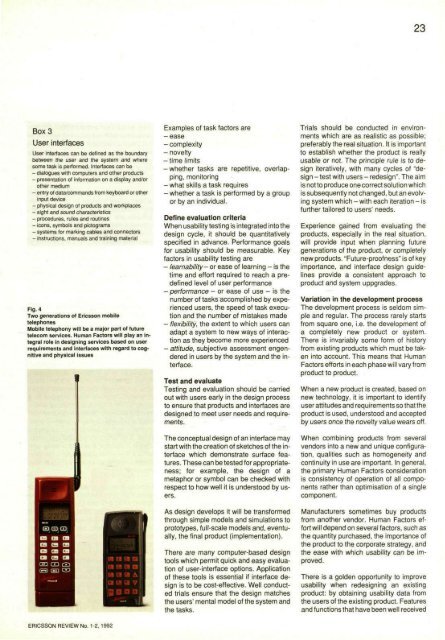Frame Relay - for Faster and More Efficient Data Communications ...
Frame Relay - for Faster and More Efficient Data Communications ...
Frame Relay - for Faster and More Efficient Data Communications ...
- No tags were found...
Create successful ePaper yourself
Turn your PDF publications into a flip-book with our unique Google optimized e-Paper software.
23Box 3User interfacesUser interfaces can be defined as the boundarybetween the user <strong>and</strong> the system <strong>and</strong> wheresome task is per<strong>for</strong>med. Interfaces can be- dialogues with computers <strong>and</strong> other products- presentation of in<strong>for</strong>mation on a display <strong>and</strong>/orother medium- entry of data/comm<strong>and</strong>s from keyboard or otherinput device- physical design of products <strong>and</strong> workplaces- sight <strong>and</strong> sound characteristics- procedures, rules <strong>and</strong> routines- icons, symbols <strong>and</strong> pictograms- systems <strong>for</strong> marking cables <strong>and</strong> connectors- instructions, manuals <strong>and</strong> training materialFig. 4Two generations of Ericsson mobiletelephonesMobile telephony will be a major part of futuretelecom services. Human Factors will play an integralrole in designing services based on userrequirements <strong>and</strong> interfaces with regard to cognitive<strong>and</strong> physical issuesExamples of task factors are-ease- complexity- novelty- time limits-whether tasks are repetitive, overlapping,monitoring- what skills a task requires- whether a task is per<strong>for</strong>med by a groupor by an individual.Define evaluation criteriaWhen usability testing is integrated into thedesign cycle, it should be quantitativelyspecified in advance. Per<strong>for</strong>mance goals<strong>for</strong> usability should be measurable. Keyfactors in usability testing are- learnability- or ease of learning - is thetime <strong>and</strong> ef<strong>for</strong>t required to reach a predefinedlevel of user per<strong>for</strong>mance- per<strong>for</strong>mance - or ease of use - is thenumber of tasks accomplished by experiencedusers, the speed of task execution<strong>and</strong> the number of mistakes made- flexibility, the extent to which users canadapt a system to new ways of interactionas they become more experienced- attitude, subjective assessment engenderedin users by the system <strong>and</strong> the interface.Test <strong>and</strong> evaluateTesting <strong>and</strong> evaluation should be carriedout with users early in the design processto ensure that products <strong>and</strong> interfaces aredesigned to meet user needs <strong>and</strong> requirements.The conceptual design of an interface maystart with the creation of sketches of the interfacewhich demonstrate surface features.These can be tested <strong>for</strong> appropriateness;<strong>for</strong> example, the design of ametaphor or symbol can be checked withrespect to how well it is understood by users.As design develops it will be trans<strong>for</strong>medthrough simple models <strong>and</strong> simulations toprototypes, full-scale models <strong>and</strong>, eventually,the final product (implementation).There are many computer-based designtools which permit quick <strong>and</strong> easy evaluationof user-interface options. Applicationof these tools is essential if interface designis to be cost-effective. Well conductedtrials ensure that the design matchesthe users' mental model of the system <strong>and</strong>the tasks.Trials should be conducted in environmentswhich are as realistic as possible;preferably the real situation. It is importantto establish whether the product is reallyusable or not. The principle rule is to designiteratively, with many cycles of "design- test with users - redesign". The aimis not to produce one correct solution whichis subsequently not changed, but an evolvingsystem which - with each iteration - isfurther tailored to users' needs.Experience gained from evaluating theproducts, especially in the real situation,will provide input when planning futuregenerations of the product, or completelynew products. "Future-proofness" is of keyimportance, <strong>and</strong> interface design guidelinesprovide a consistent approach toproduct <strong>and</strong> system uppgrades.Variation in the development processThe development process is seldom simple<strong>and</strong> regular. The process rarely startsfrom square one, i.e. the development ofa completely new product or system.There is invariably some <strong>for</strong>m of historyfrom existing products which must be takeninto account. This means that HumanFactors ef<strong>for</strong>ts in each phase will vary fromproduct to product.When a new product is created, based onnew technology, it is important to identifyuser attitudes <strong>and</strong> requirements so that theproduct is used, understood <strong>and</strong> acceptedby users once the novelty value wears off.When combining products from severalvendors into a new <strong>and</strong> unique configuration,qualities such as homogeneity <strong>and</strong>continuity in use are important. In general,the primary Human Factors considerationis consistency of operation of all componentsrather than optimisation of a singlecomponent.Manufacturers sometimes buy productsfrom another vendor. Human Factors ef<strong>for</strong>twill depend on several factors, such asthe quantity purchased, the importance ofthe product to the corporate strategy, <strong>and</strong>the ease with which usability can be improved.There is a golden opportunity to improveusability when redesigning an existingproduct: by obtaining usability data fromthe users of the existing product. Features<strong>and</strong> functions that have been well receivedERICSSON REVIEW No. 1-2. 1992















